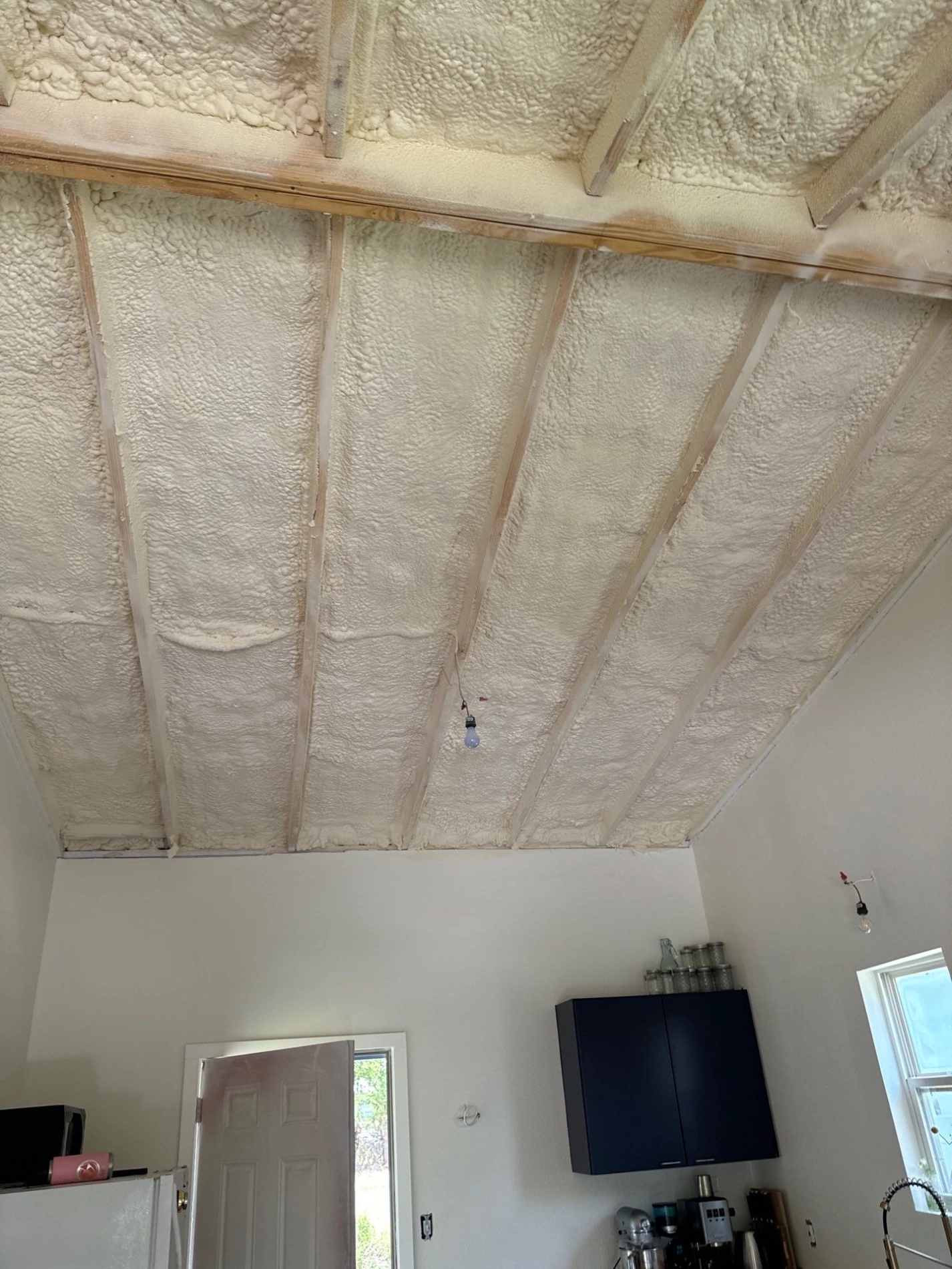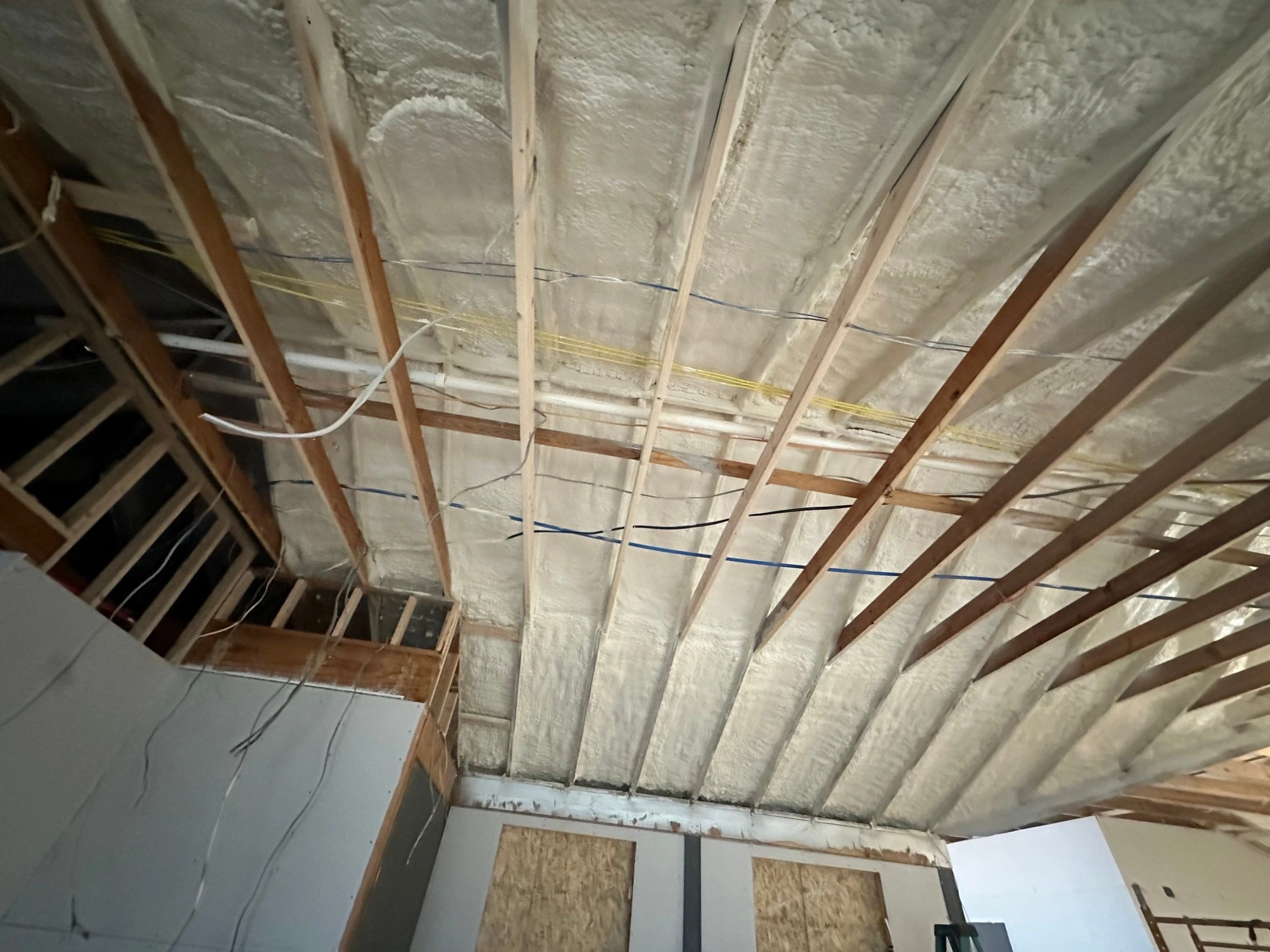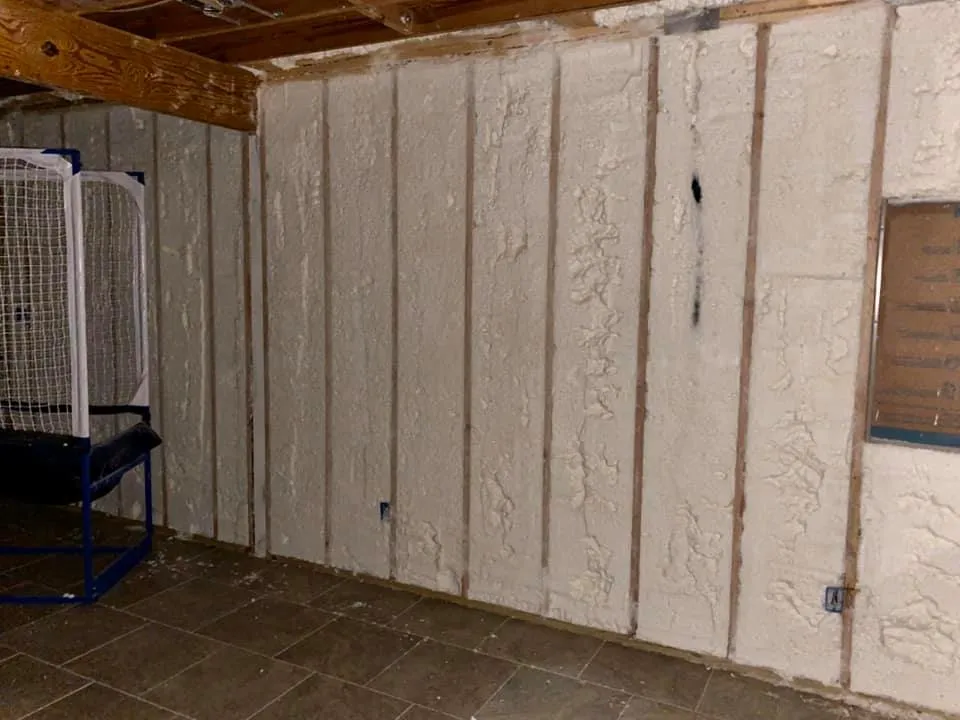Installing closed-cell spray foam requires strict adherence to comprehensive safety protocols to protect both installers and occupants from chemical exposure, respiratory hazards, and potential health risks. The primary precautions include proper ventilation systems, complete personal protective equipment (PPE), temperature and humidity monitoring, and evacuation of all occupants and pets from the premises during application and curing periods.
Professional installation teams must implement multiple safety layers including respiratory protection with supplied-air systems, chemical-resistant clothing, and continuous air quality monitoring throughout the process. These measures become critical due to the isocyanate compounds in spray foam that can cause severe respiratory sensitization and long-term health complications when proper safety protocols are not followed.
Understanding these safety requirements ensures successful installation while protecting everyone involved in the process. The following comprehensive guidelines detail each essential safety measure based on industry standards and practical installation experience.
Essential Personal Protective Equipment Requirements
Closed-cell spray foam installation demands comprehensive PPE that creates complete barriers between installers and chemical exposure. The multi-component nature of spray foam systems releases potentially harmful vapors and particles that require specialized protection beyond standard construction safety gear.
Respiratory Protection Systems Professional installers must use supplied-air respirators rather than standard filtering masks. These systems provide continuous clean air flow independent of ambient air quality, preventing exposure to isocyanates and other chemical compounds. Half-face or full-face supplied-air masks connect to clean air sources positioned outside the work area.
Emergency escape respirators serve as backup protection when primary systems fail or during equipment transitions. These self-contained breathing apparatus units provide 10-15 minutes of emergency air supply, allowing safe evacuation from contaminated areas.
Chemical-Resistant Clothing and Skin Protection Complete skin coverage prevents direct chemical contact through specialized clothing systems. Chemical-resistant suits made from materials like Tyvek or similar barrier fabrics protect against liquid splash and vapor penetration. These suits must be worn over regular clothing and sealed at wrists, ankles, and neck openings.
Nitrile or neoprene gloves provide hand protection, while chemical-resistant boots prevent foot exposure. Eye protection through goggles or face shields prevents splash contact with sensitive tissues.
Critical Ventilation and Air Quality Management
Proper ventilation systems form the foundation of safe spray foam installation by controlling chemical vapor concentrations and maintaining breathable air quality for post-installation occupancy. Inadequate ventilation creates dangerous accumulations of volatile organic compounds and isocyanate particles.
Mechanical Ventilation Requirements High-powered exhaust fans positioned strategically throughout work areas create negative pressure that draws contaminated air away from application zones. These systems must generate minimum air exchange rates of 6-10 air changes per hour during active spraying operations.
Fresh air intake systems balance exhaust ventilation by introducing clean outdoor air into work spaces. This positive pressure differential prevents vapor migration to adjacent areas and maintains consistent air flow patterns that carry contaminants toward exhaust points.
Post-Application Air Quality Monitoring Professional air quality testing determines when spaces become safe for re-occupancy. These tests measure specific chemical concentrations including methylene diphenyl diisocyanate (MDI) and other volatile compounds that may persist after visible curing.
Temperature and humidity conditions significantly impact curing rates and chemical off-gassing periods. Optimal conditions of 65-85°F and 40-60% relative humidity accelerate proper curing while minimizing extended off-gassing periods.
Temperature and Environmental Control Factors
Environmental conditions directly influence spray foam application safety and performance characteristics. Improper temperature and humidity levels create application failures, extended curing periods, and increased safety risks through prolonged chemical exposure.
| Environmental Factor | Safe Range | Impact on Safety |
|---|---|---|
| Temperature | 65-85°F | Ensures proper chemical reaction and curing |
| Humidity | 40-60% RH | Prevents moisture interference and off-gassing |
| Air Movement | 0.5-2 mph | Controls overspray without disrupting application |
| Atmospheric Pressure | Standard ± 5% | Maintains consistent spray pattern and coverage |
Climate-Specific Considerations for Different Regions Hot, humid climates require enhanced dehumidification systems and extended ventilation periods due to slower chemical curing in high moisture conditions. Desert environments with low humidity may accelerate curing but increase static electricity risks that require additional grounding precautions.
Cold weather installations demand pre-heating of substrate surfaces and extended temperature monitoring to ensure proper chemical reactions. Northern climates often require temporary heating systems to maintain safe application temperatures throughout the installation process.
Bonus Tip: Install continuous temperature and humidity monitoring systems with data logging capabilities to document proper environmental conditions throughout the installation process, providing valuable documentation for warranty and quality assurance purposes.
Occupant Safety and Evacuation Protocols
Complete evacuation of all people and pets from the installation area represents a non-negotiable safety requirement during spray foam application. Chemical sensitization can occur with minimal exposure, making prevention through total avoidance the only acceptable approach.
Pre-Installation Preparation All occupants must vacate the premises at least 2-4 hours before spray foam application begins, allowing installation teams to establish proper safety systems without interference. This preparation period includes removing or protecting sensitive items, plants, and food products that could absorb chemical odors.
Pet evacuation requires special attention since animals show increased sensitivity to chemical vapors. Pets should remain off-site for extended periods, often 24-48 hours longer than human occupants, depending on air quality test results.
Re-Entry Timing and Procedures Professional air quality testing determines safe re-entry timing rather than relying on arbitrary time periods or odor absence. Chemical concentrations can remain dangerous even when odors dissipate, making objective testing essential for occupant safety.
Initial re-entry should be limited to brief periods with windows and doors open to promote continued air circulation. Full occupancy typically occurs 24-72 hours after installation completion, contingent on air quality verification results.
Equipment Safety and Maintenance Standards
Spray foam application equipment operates under high pressure and temperature conditions that create additional safety hazards beyond chemical exposure. Proper equipment maintenance and operational procedures prevent accidents, chemical spills, and system failures that compromise safety protocols.
Pressure System Safety High-pressure spray systems operate at 800-1500 PSI, creating significant injury risks from equipment failure or improper handling. Daily pressure testing and hose inspection identify potential failure points before they create dangerous situations.
Emergency shut-off systems must be easily accessible and clearly marked throughout work areas. These systems allow immediate pressure relief and chemical flow stoppage during emergency situations.
Chemical Handling and Storage Raw materials require temperature-controlled storage and handling procedures that prevent premature reactions or degradation. Chemical components stored at improper temperatures can become unstable or lose effectiveness, creating safety hazards and application failures.
Spill containment systems and emergency response materials must be readily available during all phases of installation. These include absorbent materials, neutralizing agents, and emergency eyewash stations positioned throughout work areas.
Things to Consider Before Making a Decision
Several critical factors determine whether closed-cell spray foam installation aligns with your specific situation and safety requirements. Evaluating these considerations prevents costly mistakes and ensures optimal results.
- Property Occupancy Timeline: Consider your ability to vacate the premises for extended periods during and after installation. Projects requiring minimal disruption may benefit from alternative insulation methods that don’t require complete evacuation protocols.
- Existing Ventilation Infrastructure: Assess current ventilation capabilities and potential upgrade requirements. Properties with limited natural ventilation or HVAC systems may require additional mechanical ventilation investments to support safe spray foam installation.
- Sensitivity and Health Considerations: Individuals with respiratory sensitivities, chemical allergies, or compromised immune systems require extended precautionary measures. Medical conditions affecting breathing or chemical tolerance may necessitate alternative insulation approaches.
- Seasonal Timing and Weather Patterns: Regional climate patterns influence optimal installation timing and safety requirements. Planning installations during favorable weather conditions reduces environmental control costs and accelerates safe re-occupancy timing.
- Professional Installation Requirements: Closed-cell spray foam demands experienced professional installation teams with proper equipment, training, and safety protocols. DIY installation attempts create unacceptable safety risks and typically void material warranties.
Stellrr Insulation & Spray Foam Professional Services
When safety and performance matter most for your insulation project, professional expertise ensures proper installation while protecting your family and property. Stellrr Insulation & Spray Foam provides comprehensive closed-cell spray foam services with complete safety protocol implementation.
- Residential Spray Foam Insulation: Complete home insulation solutions using advanced closed-cell spray foam technology with full safety compliance and air quality verification protocols.
- Commercial Spray Foam Insulation: Large-scale commercial and industrial spray foam applications with specialized safety systems designed for occupied buildings and sensitive environments.
- Closed Cell Insulation: Premium closed-cell spray foam installation services featuring comprehensive safety measures, environmental controls, and post-installation air quality testing.
- Insulation Removal: Safe removal of existing insulation materials with proper containment and disposal procedures, preparing spaces for new spray foam installation.
Market Data and Industry Standards
According to the Spray Polyurethane Foam Alliance (SPFA), proper safety protocol implementation reduces installation-related health incidents by over 95% compared to inadequate safety measures. This dramatic improvement demonstrates the critical importance of comprehensive safety planning.
The Environmental Protection Agency (EPA) reports that isocyanate exposure represents the leading cause of occupational asthma in developed countries, making respiratory protection absolutely essential during spray foam installation. Professional installation teams with proper safety training show incident rates 87% lower than inadequately trained applicators.
Industry studies from the International Association of Certified Home Inspectors indicate that properties with properly installed closed-cell spray foam maintain 40-60% better air quality scores compared to traditional insulation methods when professional safety protocols are followed throughout the installation process.
Bonus Tip: Request documentation of all safety certifications and insurance coverage from installation contractors, ensuring they maintain current SPFA certification and carry adequate liability coverage for chemical exposure incidents.

Comprehensive Safety Assessment and Technical Specifications
Understanding the technical aspects of spray foam safety helps property owners make informed decisions and verify proper installation procedures. These specifications provide benchmarks for evaluating professional installation practices.
| Safety Component | Specification | Verification Method |
|---|---|---|
| Respiratory Protection | Supplied-air system, 10+ CFM | Visual inspection, airflow testing |
| Ventilation Rate | 6-10 air changes/hour minimum | Air velocity measurement |
| Re-entry Air Quality | <10 ppb isocyanates | Professional air sampling |
| Temperature Control | 65-85°F application range | Continuous monitoring |
| Pressure Systems | 800-1500 PSI with safety relief | Daily pressure testing |
Chemical Exposure Limits and Monitoring Occupational Safety and Health Administration (OSHA) establishes permissible exposure limits for isocyanates at 20 parts per billion (ppb) as a ceiling limit. Professional air quality testing must verify concentrations below these thresholds before occupant re-entry.
Time-weighted average exposures over 8-hour periods should not exceed 5 ppb for methylene diphenyl diisocyanate, the primary isocyanate component in closed-cell spray foam systems. These stringent limits require sophisticated monitoring equipment and professional interpretation.
Regional Climate Adaptation Strategies Coastal areas with high salt content in the air may require enhanced corrosion protection for spray equipment and extended ventilation periods due to chemical interactions with salt particles. Mountain regions with low atmospheric pressure need adjusted spray pressure settings and modified ventilation calculations.
Southern regions with extended high-temperature periods require enhanced cooling systems for chemical storage and application equipment. Northern climates demand pre-heating protocols for substrate surfaces and modified curing time calculations based on temperature variations.
Common Questions About Spray Foam Safety
How long should I stay out of my home during spray foam installation?
Evacuation timing depends on project size, ventilation conditions, and air quality testing results. Typically, occupants should plan for 24-48 hours away from the property, with final re-entry timing determined by professional air quality verification rather than arbitrary time periods.
Can I do anything to prepare my home for safer spray foam installation?
Remove all food items, medications, and personal care products from the installation area. Cover or remove plants, artwork, and sensitive electronics. Ensure pets are relocated to safe locations well in advance of the scheduled installation date.
What happens if safety protocols are not followed properly?
Inadequate safety measures can result in respiratory sensitization, chemical burns, property damage, and long-term health complications. These risks make professional installation with proper safety protocols essential rather than optional considerations.
How do I verify that my installer follows proper safety standards?
Request documentation of SPFA certification, insurance coverage, and safety protocol checklists. Legitimate professional installers willingly provide this information and explain their safety procedures in detail before beginning work.
Bonus Tip: Schedule installations during favorable weather conditions when natural ventilation can supplement mechanical systems, reducing overall chemical exposure periods and accelerating safe re-occupancy timing.
Protecting Your Investment Through Proper Safety Implementation
Closed-cell spray foam installation represents a significant investment in your property’s energy efficiency and comfort. Proper safety protocol implementation protects this investment while ensuring the health and safety of everyone involved in the process.
The comprehensive safety measures outlined above form the foundation for successful spray foam installation that delivers long-term performance benefits without compromising occupant health. Professional installation teams with proper equipment, training, and safety protocols ensure optimal results while minimizing risks.
Consider your specific circumstances, including occupancy requirements, existing ventilation capabilities, and individual health sensitivities when planning spray foam installation. These factors influence safety protocol requirements and may affect project timing or alternative material selection.
Get Expert Insulation Guidance
Professional spray foam installation requires specialized knowledge, equipment, and safety expertise that ensures optimal results while protecting your family and property. Don’t compromise on safety when making this important investment in your home’s performance and efficiency.
Stellrr Insulation & Spray Foam brings extensive experience in safe closed-cell spray foam installation with comprehensive safety protocols and post-installation verification procedures. Our certified professionals maintain current safety training and use industry-leading equipment to ensure proper installation while minimizing risks.
Contact Stellrr Insulation & Spray Foam today to discuss your project requirements and learn how proper safety implementation protects your investment while delivering superior insulation performance.
Phone: (512) 710-2839
Email: info@stellrr.com
Our experienced team provides detailed safety consultations, project planning, and professional installation services that meet or exceed industry safety standards for your peace of mind and protection.
Frequently Asked Questions
What are the long-term health risks if safety precautions are ignored during spray foam installation?
Inadequate safety measures during installation can lead to isocyanate sensitization, a condition causing permanent respiratory problems including asthma, reduced lung function, and hypersensitivity reactions. Once sensitized, individuals may experience severe reactions to minimal future exposures, making prevention through proper safety protocols absolutely critical.
How can I tell if my home’s air is safe after spray foam installation?
Professional air quality testing using calibrated instruments provides the only reliable method to verify safe air conditions. Visual inspection and odor absence are insufficient indicators, as harmful chemical concentrations can persist without detectable smells. Certified indoor air quality specialists should conduct testing using methods approved by EPA and OSHA standards.
What should I do if I experience symptoms after spray foam installation?
Seek immediate medical attention if you experience respiratory distress, skin irritation, eye irritation, or unusual odor sensitivity after spray foam installation. Document your symptoms and the timeline of exposure for medical professionals. Contact the installation company immediately to arrange emergency air quality testing and ventilation enhancement.
Are there safer alternatives to traditional closed-cell spray foam?
Bio-based spray foam formulations using plant-derived components reduce some chemical exposure risks while maintaining similar performance characteristics. However, all spray foam systems require professional installation with comprehensive safety protocols. Alternative insulation methods like mineral wool or cellulose may be appropriate for individuals with chemical sensitivities.
How do I verify that my contractor has proper safety training and equipment?
Request documentation of current SPFA (Spray Polyurethane Foam Alliance) certification, OSHA training records, and equipment calibration certificates. Legitimate contractors provide safety protocol checklists, insurance documentation, and references from recent projects. Verify their supplied-air respirator systems, air quality testing capabilities, and emergency response procedures before signing contracts.





